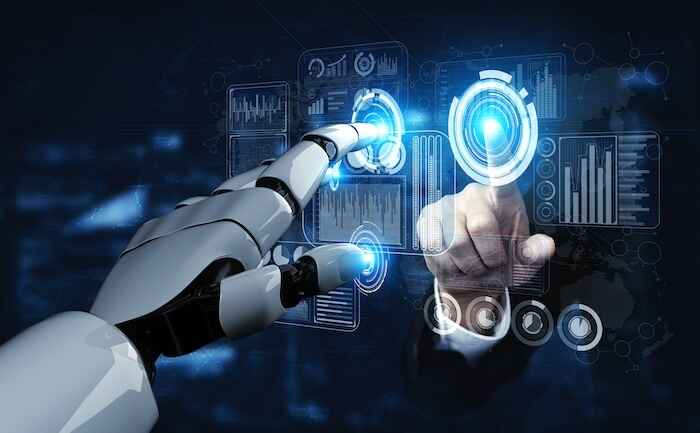Our Investment U Conference at the beautiful Ojai Valley Inn & Spa last week was a great success.
Aside from the picture-perfect location and venue, we had analysts address the outlook for stocks, bonds, commodities, currencies, crypto, real estate, collectibles and many other asset classes.
But the best part for me personally were the talks on the future of artificial intelligence (AI), given by author and futurist Dr. Shawn DuBravac and entrepreneur and consultant Brad Costanzo.
(You may have caught Shawn when he appeared with me for an Oxford Clubroom session a few weeks ago.)
This was the first time I’d met Brad Costanzo. And I was impressed.
I’ve read and listened to a lot of AI “generalists” over the past few years. But Brad’s presentation was full of concrete examples of how entrepreneurs and executives can use AI to grow their business, cut costs, improve productivity and increase profits.
Brad calls his business “Accelerated Intelligence” because AI is essentially a tool to accelerate creativity and productivity.
He used his talk to discuss how businesses can integrate AI into their operations to improve productivity several-fold.
For example, he noted that AI can turn Human Resources into Superhuman Resources.
How? Well, consider this…
AI never eats, sleeps or takes a bathroom break.
It is a partner that never tires, never runs out of ideas, never takes your requests personally, and finishes projects faster than you can delegate them to another human being.
Will AI destroy jobs? You bet.
But that’s not a bad thing, necessarily.
Most Americans used to work in agriculture. Mechanization changed that. But farm workers found other productive jobs.
Tens of millions of Americans used to work in manufacturing. Automation and cheap overseas labor changed that. But assembly line workers found other productive jobs.
The internet eliminated millions of jobs, especially for middlemen who were suddenly no longer needed. But we are all better off with the internet. And displaced workers found other jobs, as they always do.
(After all these upheavals – including the advent of AI – unemployment is near record lows.)
So, yes, AI will destroy some jobs. But it will create millions of others.
In a chat with Brad this week, I told him that if I had to pick the one career path with the best potential right now it would be showing executives and workers how to use the power of artificial intelligence to enhance their business.
He agreed, as you might expect of someone who owns a thriving AI consultancy.
(If you’d like to reach Brad to learn how AI can improve your own business, feel free to contact him at acceleratedintelligence.ai or brad@acceleratedintelligence.ai.)
What, specifically, can AI do for your business?
Researching, writing, strategizing, analyzing, planning, brainstorming, summarizing, communicating or essentially helping with any task that could use massive data processing and critical thinking skills to augment human intelligence.
In his presentation, Brad demonstrated how AI can create graphic art, edit copy, boost research or even translate your spoken videos into any foreign language.
I often point out that most businesses appeal to customers by providing a product or service that is better, faster or cheaper.
Brad calls this the “Service Trilemma.”
Using a Venn diagram, he showed that if a product is good and fast, it’s not likely to be cheap.
If it’s cheap and fast, it’s not likely to be good.
And if it’s good and cheap, it’s not likely to be fast.
Yet he showed how AI will revolutionize business by making products and services better and cheaper while delivering them faster.
That’s why AI is such a big deal.
It is pushing the boundaries of how computers – and the machines they operate – can make our lives better and easier.
AI offers the skills and algorithms to process information and reach conclusions from big data incredibly quickly.
It helps computers perform many humanlike tasks, such as data collection and entry, invoice generation, email responses to customer queries, and software testing.
This frees workers to focus on tasks that do require human abilities.
And the investment opportunities here are immense.
The world now creates 2.5 quintillion bytes of data each day.
Artificial intelligence is the only way to effectively process and use all this information.
(Already, more than 35% of companies now use some form of AI in their business.)
AI enables computers, robots, and other connected devices to mimic the perception, learning, problem-solving and decision making of the human mind.
This allows machines to perform specific tasks with increasing accuracy and without human intervention.
Applications are now used for speech recognition, language processing, virus and spam prevention, autopilot technology, image recognition, real-time recommendations, even automated stock trading.
Anything that can be achieved by human intelligence can be sped up and enhanced by AI.
People will have better outcomes across virtually every domain of human activity: including comprehension, creativity, conflict resolution, health, and longevity.
In short, very soon every businessperson will have an infinitely patient, infinitely knowledgeable, infinitely helpful partner – that never sleeps, gets sick or takes vacations – available 24/7.
This means productivity – doing more with less – will accelerate dramatically, driving economic growth, creating new ideas, new jobs, and whole new industries.
AI will augment human intelligence to solve problems better and faster than ever before.
In my view, by the end of this decade there will be only two types of companies.
Those that have integrated AI into their business. And those that don’t exist anymore.
Credit: Source link














